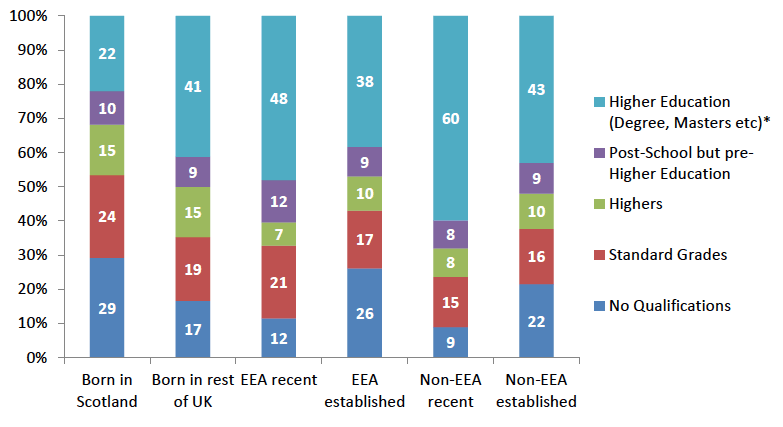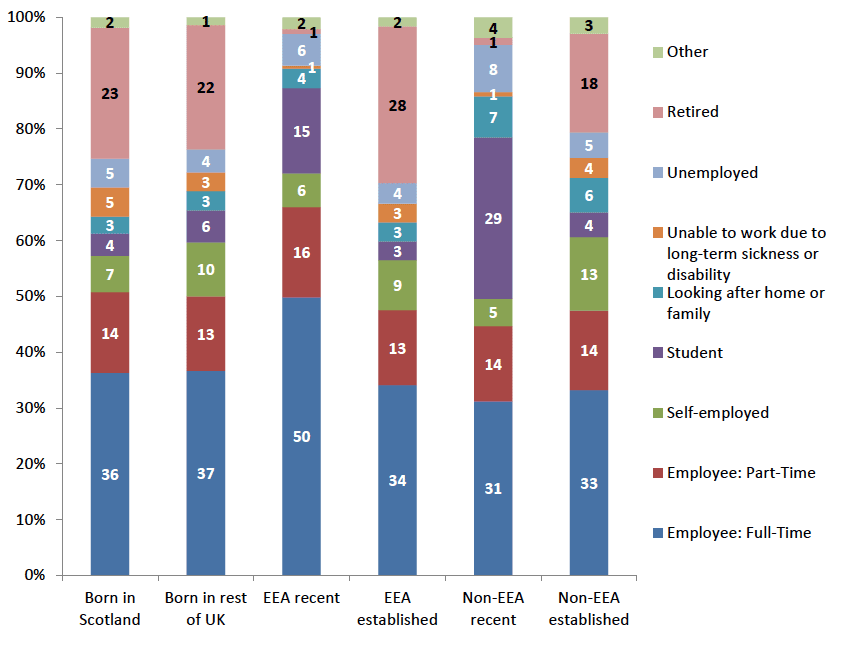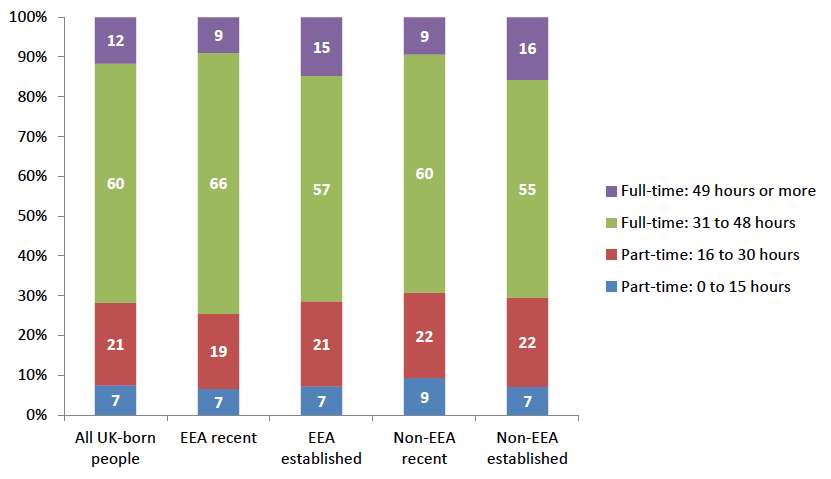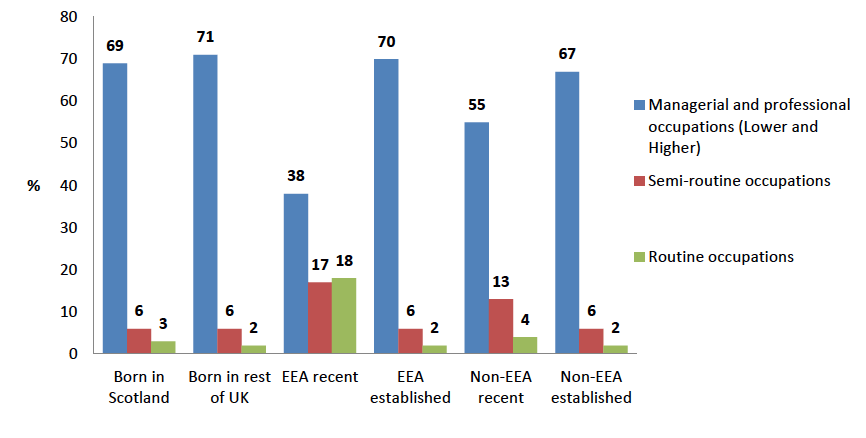Characteristics of migrants in Scotland: analysis of the 2011 census
Analysis of data from the 2011 census on the characteristics of migrants in Scotland. This is a revised version of a report published in March 2015.
4. Education and employment
Educational qualifications
Half of all non- UK migrants aged 16 and above (almost 164,000 people) had at least degree level qualifications. This compares to a quarter (26 per cent) of the population as a whole and, as Chart 4.1 shows, 22 per cent of people who were born in Scotland.
People from the recent non- EEA migrant group were most likely to be educated to degree level (60 per cent). It is likely that this reflects the relatively large proportion of students in this group (see Chart 4.2).
Around a quarter of established EEA and non- EEA migrants (just over 31,000 people) reported having no qualifications. The equivalent proportion of recent migrants with no qualifications was around 10 per cent (20,000 people). 29 per cent of people born in Scotland (1,043,000) had no qualifications.
Chart 4.1. Educational qualifications, Scotland-born and all migrants (all people aged 16 and over)

Source: Scotland's Census 2011 - NRS: Table AT_081b_2011. * Includes foreign qualifications
Economic activity
Chart 4.2 provides a breakdown of economic activity in relation to the Scotland-born population and all migrant groups. At least 50 per cent of the Scotland-born population and all migrant groups (aged 16 and over) were in full- or part-time employment, or were self-employed. The highest percentage was among recent EEA migrants (72 per cent) and lowest among non- EEA recent migrants (50 per cent). However, as noted in the previous section, the non- EEA recent group had a high proportion of students (almost 30 per cent, or 30,000).
Patterns of economic activity in the established non- UK migrant groups were similar to those among people born in Scotland and the rest of the UK. Although percentages are similar, however, the numbers are very different: 29,000 people in the established migrant groups were retired. This compares with 838,500 (born in Scotland) and 105,500 (born in the rest of the UK).
Just one per cent of recent EEA and one per cent of recent non- EEA migrants (2,000 people) were retired; and one per cent of each recent group were unable to work due to long-term sickness or disability (1,300 people).
Chart 4.2. Economic activity: Scotland-born and all migrants (all people aged 16 and over)

Source: Scotland's Census 2011 - NRS: Table AT_082b_2011.
Sector of employment
Table 4.1 provides a breakdown of Scotland's population by sector of employment. The shading in the table relates to the sectors of employment for the highest percentages of each population group. The pattern is similar across the groups, with the largest percentages employed in the wholesale and retail trade and human health and social work. The exception is recent EEA migrants, who were most likely to be working in manufacturing, or in accommodation and food service activities. 15 per cent of non- EEA recent migrants were also working in accommodation and food services. There appears to be no correlation between levels of qualifications and sector of employment. (See Chart 4.5, later in this section, for more detailed analysis).
Table 4.1. Sector of Employment: Scotland-born and all migrants aged 16 to 74 in employment
| All 16-74 in employment % | Born in Scotland % | Born in rest of UK % | EEA recent % | EEA established % | Non- EEA recent % | Non- EEA established % | |
|---|---|---|---|---|---|---|---|
| Agriculture, Forestry, Fishing; Electricity, Gas, Mining; Water Supply, Waste Management (A,B,D,E) | 5 | 5 | 5 | 5 | 4 | 4 | 3 |
| Manufacturing (C) | 8 | 8 | 6 | 17 | 6 | 4 | 5 |
| Construction (F) | 8 | 9 | 5 | 6 | 5 | 2 | 4 |
| Wholesale and retail trade; repair of motor vehicles and motorcycles (G) | 15 | 16 | 12 | 11 | 12 | 13 | 15 |
| Transport and storage (H) | 5 | 5 | 4 | 4 | 4 | 3 | 4 |
| Accommodation and food service activities (I) | 6 | 5 | 6 | 19 | 9 | 15 | 14 |
| Information and communication (J) | 3 | 3 | 4 | 2 | 4 | 5 | 3 |
| Financial and insurance activities (K) | 5 | 5 | 5 | 2 | 4 | 6 | 4 |
| Real estate activities (L) | 1 | 1 | 1 | 1 | 1 | 1 | 1 |
| Professional, scientific and technical activities (M) | 5 | 5 | 8 | 4 | 7 | 7 | 7 |
| Administrative and support service activities (N) | 4 | 4 | 4 | 8 | 4 | 5 | 3 |
| Public administration and defence (O) | 7 | 7 | 9 | 2 | 6 | 3 | 5 |
| Education (P) | 8 | 8 | 11 | 6 | 12 | 9 | 11 |
| Human health and social work (Q) | 15 | 15 | 15 | 8 | 16 | 20 | 16 |
| Arts; Entertainment and recreation; Other (R,S,T,U) | 5 | 5 | 6 | 4 | 5 | 4 | 5 |
Source: Scotland's Census 2011 - NRS: Table AT_084b_2011. Classification is based on the Standard Industrial Classification, 2007, letters indicate classification
Occupation
Table 4.2 provides a breakdown of the occupations of Scotland's adult population (all people aged between 16 and 74 in employment). As with sector of employment, the pattern was similar across all six of the population groups, with the exception of recent EEA migrants. These migrants were proportionally less likely to work in 'Professional Occupations' and 'Associate Professional and Technical Occupations' than the other groups. Recent EEA migrants were most likely to work in 'Elementary Occupations' (30 per cent, or more than 21,000 people).
38 per cent of Scotland's working population (over 950,000 people) were categorised as 'Managers, Directors and Senior Officials' or were in the 'Professional' or 'Associate Professional' groups. 30,000 of these people were EEA and 51,000 were non- EEA migrants.
Table 4.2. Occupation: Scotland-born and all migrants aged 16 to 74 in employment
| All 16-74 in employment % | Born in Scotland % | Born in rest of UK % | EEA recent % | EEA established % | Non- EEA recent % | Non- EEA established % | |
|---|---|---|---|---|---|---|---|
| Managers, Directors and Senior Officials | 8 | 8 | 11 | 4 | 11 | 6 | 14 |
| Professional Occupations | 17 | 15 | 25 | 13 | 25 | 29 | 26 |
| Associate Professional and Technical Occupations | 13 | 12 | 17 | 7 | 14 | 11 | 13 |
| Administrative and Secretarial Occupations | 11 | 12 | 10 | 5 | 9 | 7 | 9 |
| Skilled Trade Occupations | 13 | 13 | 9 | 14 | 10 | 8 | 11 |
| Caring, Leisure and other Service Occupations | 10 | 10 | 8 | 8 | 9 | 11 | 7 |
| Sales and Customer Service Occupations | 9 | 10 | 7 | 6 | 8 | 10 | 8 |
| Process, Plant and Machine Operatives | 8 | 8 | 5 | 12 | 5 | 3 | 4 |
| Elementary Occupations | 12 | 11 | 8 | 30 | 9 | 15 | 8 |
Source: Scotland's Census 2011 - NRS. Table AT_085b_2011. Classification is based on the Standard Occupational Classification, 2010.
Hours worked
Chart 4.3 includes a breakdown of the number of hours per week worked by people born in the UK and all non- UK migrant groups. There was very little difference between the groups, with approximately 70 per cent working full-time. People in the established non- UK migrant groups were most likely to work the longest hours.
Chart 4.3. Hours worked: UK-born and all migrants aged 16 to 74 in employment

Source: Scotland's Census 2011 - NRS: Tables AT_090_2011 and KS604SCa.
Socio-economic classification
The National Statistics Socio-economic Classification ( NS-SeC) provides an indication of socio-economic position based on occupation and employment status.
Chart 4.4 provides a detailed breakdown by NS-SeC classification. Again, it shows the high percentage of recent non- UK migrants who were full-time students (a quarter of recent EEA (23,000) and almost two in five recent non- EEA migrants (38,400).
People born in the rest of the UK, established EEA and established non- EEA migrants were proportionally more concentrated in managerial and professional occupations than recent migrants and the Scotland-born population.
The largest proportion of people in routine and semi-routine occupations were from the recent EEA group. They were more than twice as likely to be in routine or semi-routine occupations than recent non- EEA migrants.
Chart 4.4. NS-SeC: Scotland-born and all migrants aged 16 to 74

Source: Scotland's Census 2011 - NRS: Table AT_087b_2011
Socio-economic status and educational qualifications
Further analysis was conducted to investigate whether occupation and employment status outcomes for the various population groups reflect their levels of education. This analysis focused specifically on people with degree level qualifications and examined the highest and lowest NS-SeC classifications. See Chart 4.5.
Focusing on people with degree level qualifications allows the clearest picture of the labour market not making best use of migrant skills. 35 per cent of EEA recent migrants (12,300 people) were working in routine or semi-routine occupations, despite having degree level qualifications.
Over two-thirds of people with degree level qualifications who were born in Scotland and the rest of the UK, and EEA and non- EEA established populations were in managerial and professional occupations. This compares with 38 per cent of the EEA recent migrant group.
Chart 4.5. NS-SeC: Scotland-born and all migrants aged 16 to 74 with degree level qualifications, excluding full time students

Source: Scotland's Census 2011 - NRS: Table AT_087b_2011
Contact
There is a problem
Thanks for your feedback